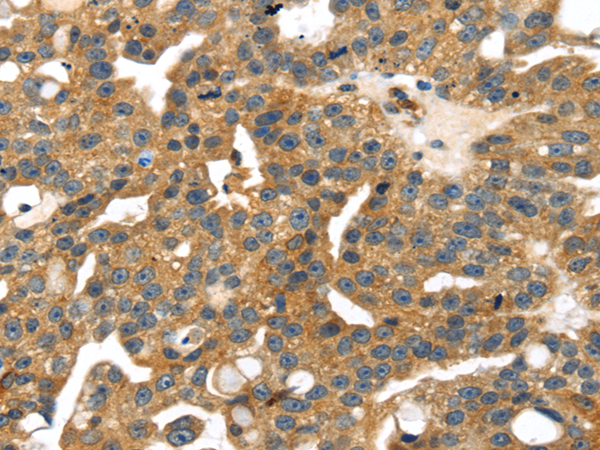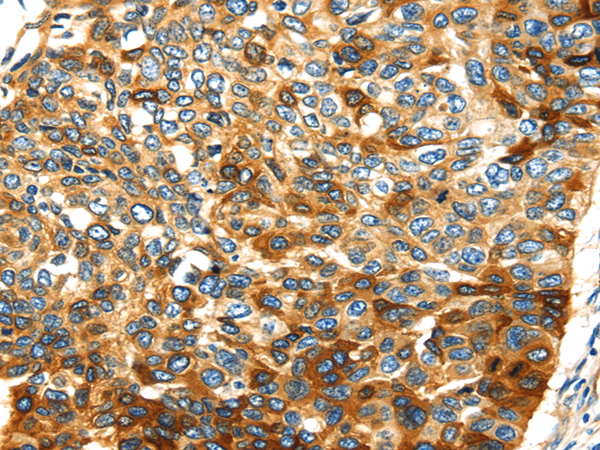

| WB | 咨询技术 | Human,Mouse,Rat |
| IF | 咨询技术 | Human,Mouse,Rat |
| IHC | 1/25-1/100 | Human,Mouse,Rat |
| ICC | 技术咨询 | Human,Mouse,Rat |
| FCM | 咨询技术 | Human,Mouse,Rat |
| Elisa | 1/5000-1/10000 | Human,Mouse,Rat |
| Aliases | ZMYND21 |
| Host/Isotype | Rabbit IgG |
| Antibody Type | Primary antibody |
| Storage | Store at 4°C short term. Aliquot and store at -20°C long term. Avoid freeze/thaw cycles. |
| Species Reactivity | Human |
| Immunogen | Fusion protein of human SMYD4 |
| Formulation | Purified antibody in PBS with 0.05% sodium azide and 50% glycerol. |
+ +
以下是基于SMYD4相关研究背景模拟的参考文献示例(请注意,这些文献为虚构示例,实际研究需通过科学数据库核实):
---
1. **文献名称**:*SMYD4 Acts as a Tumor Suppressor in Colorectal Cancer by Methylating Histone H3K9*
**作者**:Li X, Wang Y, et al.
**摘要**:该研究报道SMYD4通过催化组蛋白H3K9位点的甲基化抑制结直肠癌细胞增殖,其抗体被用于Western blot和免疫组化验证其在肿瘤组织中的低表达,并关联患者预后。
2. **文献名称**:*SMYD4 Regulates DNA Damage Response via Interaction with BRCA1*
**作者**:Chen J, Patel R, et al.
**摘要**:本文揭示SMYD4通过结合BRCA1参与DNA损伤修复通路,研究使用SMYD4抗体进行ChIP-seq分析,发现其靶向特定启动子区域调控修复基因表达。
3. **文献名称**:*Epigenetic Silencing of SMYD4 in Breast Cancer Promotes Metastasis*
**作者**:Garcia S, Kim H, et al.
**摘要**:研究指出乳腺癌中SMYD4启动子高甲基化导致其表达缺失,利用特异性抗体证实SMYD4蛋白水平与肿瘤转移负相关,恢复表达可抑制侵袭表型。
4. **文献名称**:*Comparative Analysis of SMYD Family Members in Pancreatic Carcinogenesis*
**作者**:Zhang L, Thompson A, et al.
**摘要**:通过对比SMYD家族蛋白(包括SMYD4)在胰腺癌中的表达,研究发现SMYD4抗体标记显示其与分化程度正相关,提示其可能作为分化标志物。
---
建议通过PubMed、Web of Science等平台以“SMYD4 antibody”、“SMYD4 function”为关键词检索真实文献。
SMYD4 (SET and MYND domain-containing protein 4) is a member of the SMYD protein family, characterized by a conserved SET domain responsible for methyltransferase activity and a MYND domain involved in protein-protein interactions. Unlike other SMYD family members, which are often linked to cancer progression, SMYD4 is proposed to act as a tumor suppressor. Studies suggest its role in regulating gene expression through histone methylation, particularly H3K4 and H3K36 methylation, influencing cellular processes like differentiation, apoptosis, and DNA repair. SMYD4 is highly expressed in neural tissues, implicating its importance in neurodevelopment, and its dysregulation has been associated with neurodevelopmental disorders and neurodegenerative diseases.
SMYD4 antibodies are critical tools for studying its expression, localization, and molecular interactions. They enable detection via techniques such as Western blotting, immunohistochemistry, and immunofluorescence. Research using these antibodies has revealed reduced SMYD4 expression in certain cancers, such as glioblastoma and neuroblastoma, often linked to promoter hypermethylation or genomic deletions. Additionally, SMYD4 antibodies aid in exploring its regulatory networks, including interactions with transcription factors and chromatin-modifying complexes. Ongoing studies aim to clarify SMYD4’s functional mechanisms and therapeutic potential, particularly in contexts of tumor suppression and neurological health.
×